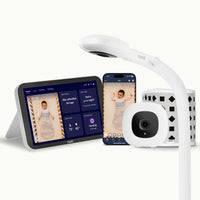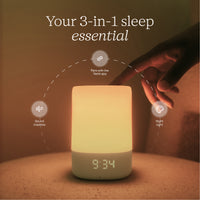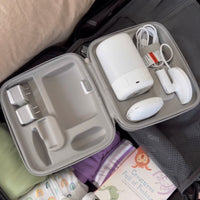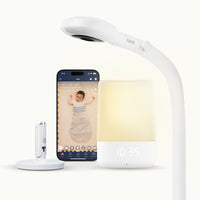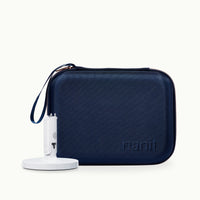It’s an exciting time when your little one approaches the wide world of solid foods and all their delicious possibilities. But questions like “When can you introduce solid foods to babies?” can make the process feel pretty daunting. Should you gradually introduce them to solids? What should you offer to your child first? Can they feed themselves or should you do it? And how should you handle potential allergens?
Nanit’s Parent Like a Pro Summits are all about arming parents with the info you need to make educated, confident decisions. To help parents ease into the world of solid food with their kiddos, we recently collaborated with Solid Starts, the leading resource on how to make the food introduction to babies, with an incredible app and First Foods Database. Our Well Fed panel featured Solid Starts experts Kary Rappaport (Senior Feeding and Swallowing Specialist with an emphasis on family mealtime dynamics) and Kim Grenawitzke (Senior Feeding and Swallowing Specialist with extensive work in pediatric acute care) and Natalie Barnett, Nanit Senior VP of Clinical Research.
The trio of pros covered all the important details on transitioning from baby food to solids, from recognizing when your infant is ready to introduce new foods, to the best first foods to try, and tips for troubleshooting some common issues and concerns.
Read on for the panel’s best tips and strategies. And bon appetit!
Get Familiar With the Signs that Your Child is Ready for Solids Including…
Overall, there’s no hard and fast rule for when a baby’s diet should contain solid foods. “When you dig into the research, there really is no clear answer,” says Grenawitzke. “ It’s not so much a specific age as it is about a child showing the skills that are needed to eat a meal.”
Here are the signs that your baby may be ready for solids:
- They are able to sit (on your lap or a high chair) and hold their body and head upright for at least five to 10 minutes. “This relates to chewing and swallowing well,” explains Grenawitzke. “We're looking for a baby to have support in their body so they can focus on the more complicated task of eating.”
They are able to use their hands while sitting, a key skill for introducing finger foods. “That skill tells me that a child is able to self feed, which is extremely important for decreasing choking risk and keeping a baby happy and engaged while they’re eating.”
They show interest in food. “A 4 month old will likely fall asleep at the table, but a young child around 6 to 7 month old is watching, engaged, and interested. Their brains are saying, ‘I think I can do that, I want to do that.’"
Stay Open Minded About First Food Options
Just as the timing for introducing a baby to solids can vary, so too can the menu of what foods to try first. “There’s no perfect first food,” says Barnett, “and there's no perfect way to feed a baby. We want to empower parents to be creative in their journey.”
“The best thing you can bring to the table is a positive, open-minded attitude,” Grenawitzke emphasizes. “If you show up feeling really anxious, your baby will pick up on that. So think about what you need to feel the most comfortable [about introducing solid foods to your infant].”
As for beverages, Rappaport says that either breastmilk/formula milk or water work. In these early stages, it’s more about learning how to use a cup than hydration, as formula and breastmilk do that job well. “Wait on introducing juice until at least 12 months and older,” she warns, “because its sweetness is so attractive to a baby. It can distract them from other foods and make them miss out on important nutrients.”
Help Your Baby Develop a Positive Attitude About Food and Eating.
Will your child someday know their way around a charcuterie plate with the best of them? Possibly! But at this early eating stage, the focus is primarily on helping your child build a positive, healthy relationship with food, exploring soft food, and discovering a big variety of flavors out there. You can help by being relaxed about your approach as your little one starts down the solid food road.
Rappaport says that, when it comes to eating, the most important thing for your baby is to associate it with fun! “In the first few months, it doesn't matter whether a baby takes one, 10, or 20 bites,” she says. “Anytime they’re at the table watching, it's a win. Those moments help create pathways in the brain that connect safety, comfort and joy with food. We can make those brain connections before they grow into a toddler.”
As far as getting used to different types and textures of foods, Rappaport says there is a window of time, generally between 6 to 8 months old, when babies are open to learning to chew. That’s the ideal time for them to experience foods that have a bit of resistance. After 9 months, it becomes slightly more challenging for a baby to tolerate new textures and learn how to chew.
One way to ease your child into the practice of chewing is to offer them larger foods that are easy to gnaw on but don’t break apart in the mouth, suggests Rappaport. “Foods like a mango pit, a raw carrot, a rib, corn on the cob, a well-cooked thick strip of steak are all good at getting your child's jaw moving in the way we want it to move and engaging their tongue. These foods provide a ton of sensory input and trigger multiple receptors.
Also, know that you can go from mashes and purees straight to steak! It’s also perfectly fine to go to soft finger foods that are easily mashed with the thumb (like a banana, avocado, etc.).”
Watch for Your Baby’s Fullness Cues.
“Your baby will tell you clearly when they are done,” says Grenawitzke. “They’ll throw their food, fuss, cry, turn their head away. And I know it’s so hard to hear, but whatever they have eaten is enough. If you can try to remind your brain that eating is a learning experience and if your baby doesn't have the interest and skill to eat whatever the food is, they can't get the benefit.”
“Around 9 months, we tend to see more swallowing,” Rappaport adds, “but you don't really have to measure spoonfuls/amount because babies should receive most of their nutrition through breastmilk or infant formula. After 12 months, they should receive more nutrients through solid foods because their nutritional needs have transitioned.
At that point what we are looking for is for a baby to transition to solid foods and a beverage. Babies don't have to transition to cow's milk. It can be milk or just water if the baby is getting calcium and vitamin D needs through solid foods.”
What are some of the common questions and issues that can come up when introducing solids? Our experts spoke to those as well.
Eating Solids Doesn’t Necessarily Translate Into Better Sleep
Will starting solids help your baby sleep through the night better? The two aren’t that closely related, say the experts.
“Introducing solids won't necessarily make your baby sleep through the night,” says Barnett. “Both milestones just tend to happen around the same time (6 to 7 months), but don't feel like if you start your baby early on solids they will suddenly sleep.”
“We wouldn't expect babies to start solids and then have a big improvement in their sleep,” reiterates Rappaport. “Both eating and sleep are developmental skills and take lots of time to hone. The breast and bottle are going to remain their primary source of nutrition for a while. It can take three to six months at least of consistent practice to chew, feel, play around with the food before a child can successfully eat enough to gain good nourishment from the solid foods.”
Introduce Allergens Early.
New recommendations from the American Academy of Allergy Immunology and Asthma encourage introducing a child to the most common potential food allergens early (4 to 6 months) to help their developing bodies get used to them. In fact, according to the Academy, delaying the introduction of allergens could increase a baby’s risk of developing allergies. And when it comes to introducing these foods into your child’s diet, gradually is the way to go.
“Introduce allergens early in a small amount, ⅛ to ¼ teaspoon,” instructs Grenawitzke. “Morning is ideal because if your child does have a reaction, it will be easier to work with your care team and farther from bedtime. If things go well, give the foods a couple more times in bigger volumes for about three days, then keep them in the diet rotation for five years.
The research on the benefits of early introduction is strongest for egg, peanut, and dairy. But the Solid Starts’ allergy specialists recommend doing the above method for all nine common allergens as much as possible. The top nine allergens are: milk, eggs, fish, shellfish, tree nuts, peanuts, wheat, soy, and sesame.” Shellfish being the least important, especially as shellfish is a higher risk food for foodborne illness in babies.
Know When to Ask for Help.
It’s also good to know when to enlist a little extra help when it comes to food safety. “ If you have been trying these strategies for a while or your baby is very uncomfortable or resistant,” says Rappaport, “it’s a great idea to reach out to someone who can provide you a bit more individualized support. You can get an evaluation or some therapy to get your child past the resistance so they can practice building these valuable skills.”
As a parent, it’s a thrilling thing to be able to introduce your child to the world’s wonders, from dinosaurs and rainbows to watermelon and ice cream. Happy exploring and above all, have fun with the journey.







